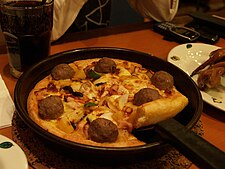 | |
| Type | Pizza |
|---|---|
| Place of origin | United States |
Pan pizza is a pizza baked in a deep dish pan or sheet pan. Turin-style pizza, Italian tomato pie, Sicilian pizza, Chicago-style pizza and Detroit-style pizza may be considered forms of pan pizza. Pan pizza also refers to the thick style popularized by Pizza Hut in the 1960s. [1] [2] The bottoms and sides of the crust become fried and crispy in the oil used to coat the pan.
A notable early version of pan pizza is the "Pizza al Padellino" from the city of Turin in Northern-Italy, with historical references since the beginning of the 20th century. [3] [4]
Dan and Frank Carney opened a pizza parlor in Wichita, Kansas which would later become Pizza Hut. At first, the brothers focused on a thin crust pizza which included cheese, pepperoni or sausage. The pizza parlor franchised into Pizza Hut in 1959 and added a thicker crust pan pizza. [5] [6]
Other pizza companies also later included pan pizza. In 1989, Domino's introduced its deep dish or pan pizza. Its introduction followed market research showing that 40% of pizza customers preferred thick crusts. The new product launch cost approximately $25 million, of which $15 million was spent on new sheet metal pans with perforated bottoms. [7]
-
Detroit-style pizza
-
Sicilian pizza
- ^ López-Alt, James Kenji. "Foolproof Pan Pizza". The Pizza Lab. Serious Eats. Retrieved December 29, 2017.
- ^ Robert Spector (September 7, 2010). The Mom & Pop Store: True Stories from the Heart of America. Bloomsbury Publishing. pp. 225–. ISBN 978-0-8027-7911-3.
- ^ "Padellini d'Italia unitevi! L'irresistibile ascesa della pizza nata a Torino". la Repubblica (in Italian). May 3, 2023. Retrieved September 12, 2023.
- ^ Canino, Francesco (April 3, 2014). "Pizza al tegaminio: riscoperta della tradizione torinese". Agrodolce (in Italian). Retrieved September 12, 2023.
- ^ Andrew F. Smith (October 28, 2013). Food and Drink in American History: A "Full Course" Encyclopedia [3 Volumes]: A "Full Course" Encyclopedia. ABC-CLIO. pp. 679–. ISBN 978-1-61069-233-5.
- ^ Andrew F. Smith (December 2, 2011). Fast Food and Junk Food: An Encyclopedia of What We Love to Eat [2 volumes]: An Encyclopedia of What We Love to Eat. ABC-CLIO. pp. 555–. ISBN 978-0-313-39394-5.
- ^ Rick Telberg (May 15, 1989). "Domino's Pizza deep-dishes it out". Nation's Restaurant News.
- ^ "Capo's". Restaurant Review. Condé Nast Traveler. Retrieved January 1, 2022.
- ^ Olmsted, Larry (March 9, 2017). "San Francisco pizza master perfects deep dish". USA TODAY. Retrieved January 1, 2022.
 | |
| Type | Pizza |
|---|---|
| Place of origin | United States |
Pan pizza is a pizza baked in a deep dish pan or sheet pan. Turin-style pizza, Italian tomato pie, Sicilian pizza, Chicago-style pizza and Detroit-style pizza may be considered forms of pan pizza. Pan pizza also refers to the thick style popularized by Pizza Hut in the 1960s. [1] [2] The bottoms and sides of the crust become fried and crispy in the oil used to coat the pan.
A notable early version of pan pizza is the "Pizza al Padellino" from the city of Turin in Northern-Italy, with historical references since the beginning of the 20th century. [3] [4]
Dan and Frank Carney opened a pizza parlor in Wichita, Kansas which would later become Pizza Hut. At first, the brothers focused on a thin crust pizza which included cheese, pepperoni or sausage. The pizza parlor franchised into Pizza Hut in 1959 and added a thicker crust pan pizza. [5] [6]
Other pizza companies also later included pan pizza. In 1989, Domino's introduced its deep dish or pan pizza. Its introduction followed market research showing that 40% of pizza customers preferred thick crusts. The new product launch cost approximately $25 million, of which $15 million was spent on new sheet metal pans with perforated bottoms. [7]
-
Detroit-style pizza
-
Sicilian pizza
- ^ López-Alt, James Kenji. "Foolproof Pan Pizza". The Pizza Lab. Serious Eats. Retrieved December 29, 2017.
- ^ Robert Spector (September 7, 2010). The Mom & Pop Store: True Stories from the Heart of America. Bloomsbury Publishing. pp. 225–. ISBN 978-0-8027-7911-3.
- ^ "Padellini d'Italia unitevi! L'irresistibile ascesa della pizza nata a Torino". la Repubblica (in Italian). May 3, 2023. Retrieved September 12, 2023.
- ^ Canino, Francesco (April 3, 2014). "Pizza al tegaminio: riscoperta della tradizione torinese". Agrodolce (in Italian). Retrieved September 12, 2023.
- ^ Andrew F. Smith (October 28, 2013). Food and Drink in American History: A "Full Course" Encyclopedia [3 Volumes]: A "Full Course" Encyclopedia. ABC-CLIO. pp. 679–. ISBN 978-1-61069-233-5.
- ^ Andrew F. Smith (December 2, 2011). Fast Food and Junk Food: An Encyclopedia of What We Love to Eat [2 volumes]: An Encyclopedia of What We Love to Eat. ABC-CLIO. pp. 555–. ISBN 978-0-313-39394-5.
- ^ Rick Telberg (May 15, 1989). "Domino's Pizza deep-dishes it out". Nation's Restaurant News.
- ^ "Capo's". Restaurant Review. Condé Nast Traveler. Retrieved January 1, 2022.
- ^ Olmsted, Larry (March 9, 2017). "San Francisco pizza master perfects deep dish". USA TODAY. Retrieved January 1, 2022.
![Tony Gemignani's Capo's[8] Dillinger, 2014 World's Best Pan Pizza[9]](https://upload.wikimedia.org/wikipedia/commons/thumb/4/4e/Dillinger.JPG/230px-Dillinger.JPG)

